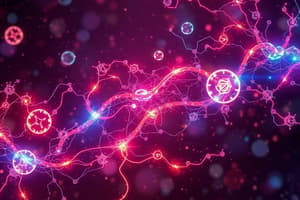Podcast
Questions and Answers
What is the primary function of catabolic pathways?
What is the primary function of catabolic pathways?
- To synthesize complex molecules from simpler ones
- To regulate enzyme activity in metabolic reactions
- To break down molecules to produce energy (correct)
- To convert light energy into chemical energy
Which metabolic pathway occurs in the cytoplasm and results in a net gain of 2 ATP?
Which metabolic pathway occurs in the cytoplasm and results in a net gain of 2 ATP?
- Oxidative Phosphorylation
- Glycolysis (correct)
- Citric Acid Cycle
- Photosynthesis
Which process uses electrons from NADH and FADH2 to produce ATP?
Which process uses electrons from NADH and FADH2 to produce ATP?
- Oxidative Phosphorylation (correct)
- Citric Acid Cycle
- Photosynthesis
- Glycolysis
Feedback inhibition is a regulatory mechanism that does what?
Feedback inhibition is a regulatory mechanism that does what?
What is a potential consequence of metabolic disorders?
What is a potential consequence of metabolic disorders?
Flashcards are hidden until you start studying
Study Notes
Metabolic Pathways
-
Definition: Series of biochemical reactions that convert a substrate into a product within a cell, involving various enzymes.
-
Types of Metabolic Pathways:
-
Catabolic Pathways:
- Break down molecules to produce energy (ATP).
- Example: Glycolysis, Citric Acid Cycle (Krebs Cycle).
-
Anabolic Pathways:
- Build complex molecules from simpler ones, requiring energy.
- Example: Protein synthesis, Glycogenesis.
-
-
Key Metabolic Pathways:
-
Glycolysis:
- Breakdown of glucose into pyruvate.
- Occurs in the cytoplasm; net gain of 2 ATP.
-
Citric Acid Cycle (Krebs Cycle):
- Completes the oxidation of substrates derived from glycolysis.
- Produces NADH, FADH2, and ATP; occurs in the mitochondria.
-
Oxidative Phosphorylation:
- Uses electrons from NADH and FADH2 to generate ATP via the electron transport chain.
- Involves chemiosmosis and occurs in the inner mitochondrial membrane.
-
Photosynthesis (for plants):
- Converts light energy into chemical energy.
- Occurs in chloroplasts; involves light-dependent and light-independent reactions (Calvin Cycle).
-
-
Regulation of Metabolic Pathways:
- Enzyme activity modulation through:
- Allosteric regulation: Enzymes change shape upon substrate binding.
- Feedback inhibition: End products inhibit early steps (e.g., ATP inhibiting phosphofructokinase in glycolysis).
- Enzyme activity modulation through:
-
Metabolic Disorders:
- Result from enzyme deficiencies (e.g., phenylketonuria from phenylalanine hydroxylase deficiency).
- Can lead to accumulation of substrates or deficits in products.
-
Importance of Metabolic Pathways:
- Energy production for cellular functions.
- Synthesis of biomolecules necessary for growth and maintenance.
- Integration of various metabolic processes to maintain homeostasis.
Metabolic Pathways
- Series of biochemical reactions converting substrates into products, involving enzymes.
Types of Metabolic Pathways
-
Catabolic Pathways:
- Decompose molecules to release energy in the form of ATP.
- Examples include glycolysis and the citric acid cycle (Krebs cycle).
-
Anabolic Pathways:
- Synthesize complex molecules from simpler ones, consuming energy.
- Examples include protein synthesis and glycogenesis.
Key Metabolic Pathways
-
Glycolysis:
- Converts glucose into pyruvate.
- Occurs in the cytoplasm, yielding a net gain of 2 ATP.
-
Citric Acid Cycle (Krebs Cycle):
- Finalizes the oxidation of substrates from glycolysis.
- Produces NADH, FADH2, and ATP, taking place in the mitochondria.
-
Oxidative Phosphorylation:
- Utilizes electrons from NADH and FADH2 to generate ATP along the electron transport chain.
- Involves chemiosmosis and occurs in the inner mitochondrial membrane.
-
Photosynthesis (in plants):
- Transforms light energy into chemical energy.
- Occurs in chloroplasts; comprises light-dependent and light-independent reactions (Calvin Cycle).
Regulation of Metabolic Pathways
- Modulated through:
- Allosteric Regulation: Enzymes alter shape when substrates bind.
- Feedback Inhibition: End products inhibit earlier steps, such as ATP inhibiting phosphofructokinase during glycolysis.
Metabolic Disorders
- Arise from enzyme deficiencies (e.g., phenylketonuria due to a deficiency of phenylalanine hydroxylase).
- Can cause substrate accumulation or product deficits.
Importance of Metabolic Pathways
- Essential for energy production to support cellular functions.
- Facilitate biosynthesis of necessary biomolecules for growth and maintenance.
- Ensure integration of various metabolic processes to uphold homeostasis.
Studying That Suits You
Use AI to generate personalized quizzes and flashcards to suit your learning preferences.




